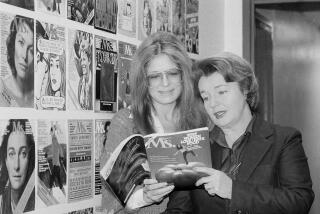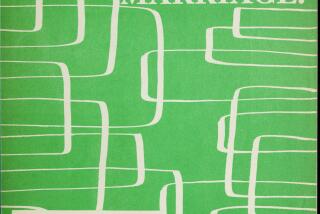Keeping Alive the Tradition of Bohemia and Intelligensia : Publishing: Three small erotic magazines--sold in upscale locations--lure those who believe sex is more than just a part of life’s routine.
- Share via
These are the three aristocrats of America’s magazine erotica: Yellow Silk (50 pages, $7.50, circulation 15,000), Libido (88 pages, $8, circulation 9,000) and Paramour (36 pages, $4.95, circulation 12,000).
Most of their staffs are women. Most of the readers are men.
Small as they are, these magazines keep alive the great free-love Kinsey-kinky-Kama-Sutra love-oil rapture tradition of a century of bohemia and intelligentsia.
A lot of readers are between 30 and 45, the editors say. One can imagine an ad: “Libido: When National Public Radio Just Isn’t Enough.”
These magazines are for them, the keepers of the flame of D.H. Lawrence, Havelock Ellis and Margaret Mead. They feature “all persuasions; no brutality,” as the motto of Yellow Silk says. This means they’re generally non-fetish, counter-S & M magazines catering to heterosexuals in a market that reaches out to ever-smaller microfetish reading populations.
Here, the High Erotic tradition lives. There’s fiction and drawings of the post-Picasso tattoo-realist persuasion, and, of course, the photographs.
The photographs are black-and-whites of male and female nudes arising from creamy shadows, artistically semi-comatose. Or they’re stippled or striped with light, or they’re solarized so they glow like visitors from the Planet Zircon.
There are rings. There are things. One sees the occasional male mysterium tremendum--something helplessly goofy about it.
Perhaps because the editors are women, there tends to be less comparable detailing of female anatomy. Presumably there’s no taboo against it after so many years of feminist celebration of the flower-petal beauties of femalia, the paintings of Judy Chicago et al.
The writing is more pornographic, but just as faithful to the tradition. There is much straddling and cupping. There is poetry. There is variety.
They buy these magazines in upscale chain bookstores like Borders. (There’s even a Spanish-language one called Temo. ) Smut for the smart, low instincts for the high-minded, they can be found in the same neighborhood as magazines such as Earth First and Homicidal Lesbian Terrorist and books with the digit titles that are popular with the same readership in cookbooks, gardening books, weight-loss books and so on: “The One-Hour Orgasm” “Seven Weeks to Better Sex,” “Sex Over 40.”
Paramour, edited by Amelia Copeland, tells advertisers that 93% of its readers have gone to college and 35% have gone to graduate school. Half make $20,000 to $60,000 a year, and 13% more than $60,000. More than a third are 36 to 45, and almost half are between 18 and 25. A third have bought a painting or sculpture recently. They read 3.74 books a month.
“Professionals,” says Jack Hafferkamp, one of Libido’s editors. “Doctors, dentists, sex therapists.”
At Yellow Silk, founded 14 years ago, founder Lily Pond says, “Our readership is getting older because we’re not into sadomasochism and young people are.”
They grew up believing in American science and foreign passion, as in Samoan adolescents or Edith Piaf singing that she regretted nothing, or Oriental love secrets of unspeakable ecstasy. Erotica was packaged in sex manuals such as “Love Without Fear,” written in a style reminiscent of Dr. Joyce Brothers telling a maitre d’ why she doesn’t want a table so close to the kitchen. There was the occasional foreign movie, such as “I Am Curious, Yellow.”
And, tucked away in Dad’s sock drawer, perhaps, a deck of cards with 52 different photographs on the backs.
Why playing cards? Because sex always has to be something else in America: art, science, nature, politics, education, the mystic lore of the East, even gin rummy.
Where else but Yellow Silk does one find the redeeming socialist value of a woman making love with two men in a scene during the Chinese revolution in 1949?
Most Americans don’t think about sex the way these magazines do. Old sex, new sex, single sex or group sex, it’s still rock ‘n’ roll to them. Sex is part of a routine, like sending out Christmas cards, or maybe teasing the dog during a rainy spell at the beach house.
*
O ungrateful ones! Unlike the readers of these magazines, they have no idea how much they owe to the upper-class cultural guerrillas of the last century, the people who taught that sex should provoke no guilt, that sex is a Tantric meditation, a political expression, a venerable frolic to be seen in the wall paintings of Pompeii, or read about in anything describable as “Rabelaisian” (any writing containing the words saucy wench is Rabelaisian).
All this lives on in these three little periodicals.
And more: In the 1950s, for instance, 14-year-old boys found aesthetic satisfaction in photography magazines, all those velour-skinned women standing on tiptoe next to pieces of driftwood. The driftwood made it art, along the lines of the driftwood clocks, driftwood coffee tables and driftwood lamps that were popular then.
Sure enough, the Golden Age of Driftwood lives on in Paramour magazine, where a woman stands on a piece of driftwood, trailing a veil from hands lifted in a yea-saying salute to whatever.
This neopaganism was also sanctioned by science, which helped turn eros into a Puritan-seeking missile. To sum up a century of study: Krafft-Ebing showed that anything was possible, and Masters and Johnson showed you could watch it without laughing.
The advertising is a tradition in itself, offering hardware, weird-wear and videotapes described with an age-old litany. There are many ads for the Kama Sutra, an Indian guide to love secrets of the East. The Kama Sutra provides much frothing and stroking, but so does washing your dog. Still, it’s a classic, like most of what’s in these magazines, and you’d feel unenlightened without it.
More to Read
Sign up for our Book Club newsletter
Get the latest news, events and more from the Los Angeles Times Book Club, and help us get L.A. reading and talking.
You may occasionally receive promotional content from the Los Angeles Times.









